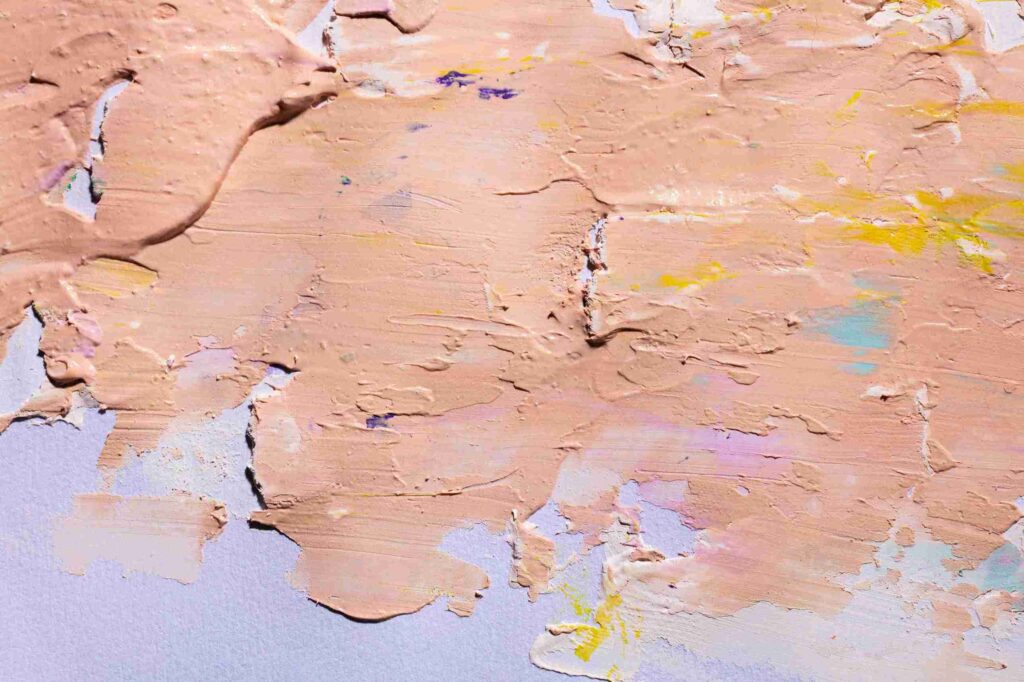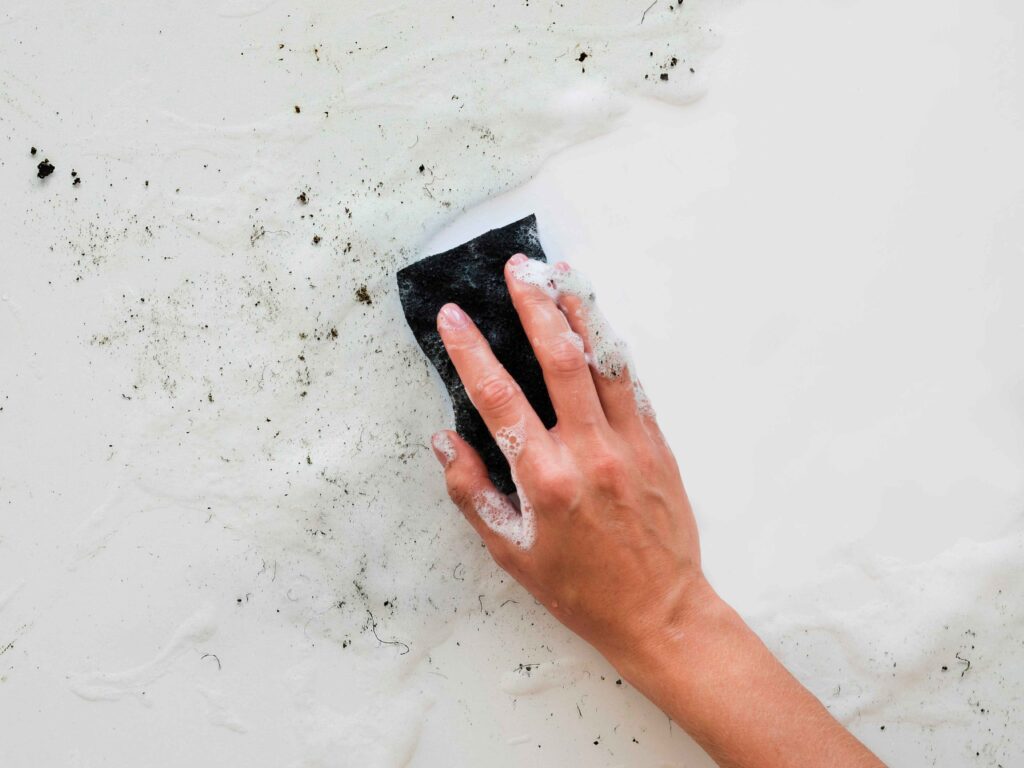- 10% Off External Painting
- Free Estimates

Flat paint walls bring a smooth, elegant finish that looks great in almost any room—but they’re also magnets for smudges, fingerprints, and scuff marks. Unlike glossy or satin finishes, flat paint lacks a protective sheen, which means it can be tricky to clean without damaging the surface. Harsh scrubbing or using the wrong products can leave behind shiny spots, discoloration, or even peel away the paint entirely.
Here are six effective ways to clean smudges off flat paint walls without ruining the finish.
✔ Flat paint offers a smooth, non-reflective finish but requires delicate cleaning methods.
✔ Always start with a dry microfiber cloth before introducing moisture.
✔ Warm water and mild soap can remove most smudges without damaging the surface.
✔ Magic Erasers work for stubborn marks but must be used gently to avoid lifting paint.
✔ Touch-up paint helps restore areas where cleaning causes discoloration.
✔ Washable paint is more durable and easier to maintain than traditional flat paint.
✔ Identifying the correct paint finish prevents costly cleaning mistakes.
✔ Working with professional painters ensures the right products and techniques are used for lasting results.

Flat paint is delicate, and sometimes the gentlest approach is the most effective. Before reaching for water or cleaning products, try removing smudges using a dry microfiber cloth. This method works best for fresh marks like dust, fingerprints, or minor scuffs, and it’s an essential first step in flat paint maintenance.
When dry methods aren’t enough, warm water and a soft sponge offer a safe next step. This gentle technique works well for light smudges and everyday dirt without compromising the paint. It’s a key part of learning how to clean walls with flat paint the right way.
Some marks need more than just water. A small amount of dish soap diluted in warm water can cut through grime without damaging the finish. Knowing how to wash flat paint walls with soap can make a noticeable difference, especially in busy areas.
Magic Erasers can be helpful, but only when used with care. Their fine abrasive texture can lift paint if misused, so they’re best for small, stubborn marks. Understanding how to clean walls with flat paint using this method takes a light touch and attention to detail.
Some smudges just won’t come off. When cleaning fails or causes visible changes to the finish, the best solution is a touch-up. It’s a common step in flat paint maintenance that restores the wall’s original look without needing to repaint the entire room.
While traditional flat paint looks elegant, it doesn’t handle cleaning well. Homeowners tired of repeated smudges might consider switching to washable flat or matte finishes. This change makes a major difference in future flat paint maintenance without sacrificing style.
Before using any cleaning method, it’s essential to identify the paint type. Flat paint has a unique texture and finish that reacts differently to moisture, pressure, and cleaning products. Misidentifying the paint can lead to streaks, damage, or even peeling, so knowing what to look for makes flat paint maintenance much easier and safer. And with the average cost to paint a home’s interior around $2,021, avoiding unnecessary damage can help protect that investment.
Flat paint has zero to minimal sheen. When light hits the wall—whether from a window or a lamp—it won’t reflect back like satin or semi-gloss finishes. This makes it a good option for hiding wall imperfections, but it also means cleaning requires more care.
Walls with flat paint feel soft and chalky, not slick or smooth like glossier finishes. This dry, almost powdery texture absorbs oils and dirt more easily. If the wall feels like it might smudge when touched, it’s likely a flat finish.
Flat paint does a great job at concealing nail holes, scratches, and uneven surfaces. It visually smooths out flaws because light doesn’t bounce off it. This quality is why professionals often recommend flat paint for ceilings or older walls that aren’t perfectly smooth.
With flat paint, the color looks the same no matter the lighting angle. There’s no variation or “highlighting” of textures that typically shows up with eggshell or satin paint. This matte consistency is a reliable indicator, especially when trying to figure out how to clean walls with flat paint safely.
Gently blot a hidden section of the wall with a damp cloth—if the spot darkens instantly and doesn’t lighten quickly, it’s likely flat paint. Be careful not to rub, as flat paint may absorb water and show signs of damage. Professionals often recommend this type of test before using any wall cleaning method.
When in doubt, contact the painting contractor or check documentation from a past renovation. Professionals typically note the paint type and brand for future maintenance. Knowing exactly what’s on the wall helps determine whether it’s safe to wash flat paint walls or consider switching to a more washable alternative.
When smudges become a constant issue, many homeowners start comparing washable vs flat paint. While both can offer a similar matte appearance, their performance during cleaning and long-term maintenance is very different.
Understanding the differences helps prevent damage and supports better choices for how to clean walls with flat paint or when it might be time to upgrade. With the global house painting service market projected to reach USD 89.4 billion by 2032, making informed paint choices is more relevant than ever.
Flat paint has no sheen—it absorbs light instead of reflecting it. Washable paints often have a slight matte or eggshell finish that reflects just enough light to resist smudges without looking glossy. This subtle difference makes washable paint easier to clean and more forgiving in busy areas.
Traditional flat paint is prone to scuffing, fading, and lifting when cleaned too often or too aggressively. Washable paint is formulated with stronger binders, allowing it to withstand damp sponges or mild cleaners without damage. For anyone learning how to wash flat paint walls, durability is a critical factor to consider.
Flat paint tends to absorb oils, dirt, and moisture, making smudges harder to remove. Washable finishes create a barrier that prevents stains from soaking in, allowing for easier cleanup with just soap and water. This feature reduces the need for constant touch-ups and extends the life of the paint job.
Flat paint works best in low-traffic, low-touch areas like ceilings or guest rooms. Washable paint is ideal for kitchens, hallways, children’s bedrooms, or laundry rooms—anywhere regular cleaning is expected. A painting professional can recommend the right product for each space based on daily use.
Touching up flat paint is usually seamless, as new paint blends easily into the old. Washable finishes, on the other hand, may show slight differences in texture or sheen if not blended carefully. It’s a trade-off: flat paint touch-ups are easier, but washable finishes need fewer repairs overall.
While flat paint is often cheaper up front, washable paint offers better long-term value through reduced maintenance and fewer repainting needs. Professional painters can guide homeowners through product options that balance appearance, cleanability, and cost. Choosing the right type at the start makes it easier to clean marks off flat paint—or avoid those marks altogether.
Even when primed and textured by a professional, a freshly painted wall can look blotchy, with its hue being leveled — but with an inconsistent sheen. And this often occurs over wall damage patched with filler or drywall. These compounds are porous, absorbing paint and dulling the surface, leaving an unsightly toned surface.
When the light goes to these dull spots, they’ll stick out and not look the best. Moreover, the smooth patch will stand out more than the bumpy textures of the whole wall. You can avoid them all by adding an extra coat of primer and removing flashing and textured surfaces.
But you can use a primer teal to patch those unsightly spots and guarantee the results won’t sink and become dull. Choose a nap thickness surrounding the wall textures, often 3/8-inch for smoother walls and half an inch for textured ones.

Yes, a clear matte sealant can be applied over flat paint to improve its cleanability without adding shine. This protective coating helps resist smudges, fingerprints, and moisture while preserving the wall’s flat appearance. It’s not a perfect solution but can reduce the effort involved in flat paint maintenance. If sealing is considered, it’s best to consult a professional who knows how to clean walls with flat paint and prep them for sealing.
Avoid products with bleach, ammonia, or strong degreasers, as they can discolor or damage flat paint quickly. Abrasive powders and heavily scented cleaners often leave visible residue or lift the paint finish. Even “gentle” multi-surface sprays may be too harsh unless diluted. To clean marks off flat paint safely, always test cleaners in an inconspicuous area first.
Older or low-quality flat paints can sometimes contain VOCs (volatile organic compounds) that slowly release into the air, especially in poorly ventilated rooms. Newer formulations often have low or zero VOC content, especially when purchased through trusted brands or professional painters. Using flat paint in bedrooms or nurseries requires attention to both aesthetics and health considerations. Whether choosing washable vs flat paint, it’s worth asking for low-VOC options during the planning stage.
Yes, it’s common for walls to feature mixed finishes depending on the area. For example, a flat paint ceiling paired with satin-finish trim helps create contrast and function. This strategy can help limit where smudges appear and simplify how to wash flat paint walls in specific zones. Professionals often recommend this approach in bathrooms, kitchens, or high-traffic living spaces.
Repainting over flat paint with a washable finish is possible, as long as the surface is properly cleaned and prepped. Any loose paint or surface dust should be removed before applying a new coat. A primer may be needed to help the washable paint adhere evenly, especially if the original wall has stains or uneven patches. Switching from flat to washable paint is a smart long-term solution for reducing smudges and simplifying flat paint maintenance.
At Brewster Best House Painting, every brushstroke is backed by craftsmanship, care, and a deep respect for the homes we serve. Whether it’s refreshing tired flat walls, upgrading to washable finishes, or restoring character with a flawless coat, our experienced team in Brewster, NY, delivers detail-driven results built to last. We don’t cut corners—we paint them clean, sharp, and smooth.
Let Brewster’s trusted painters bring lasting color and quality to every room, ceiling, and exterior on your list!